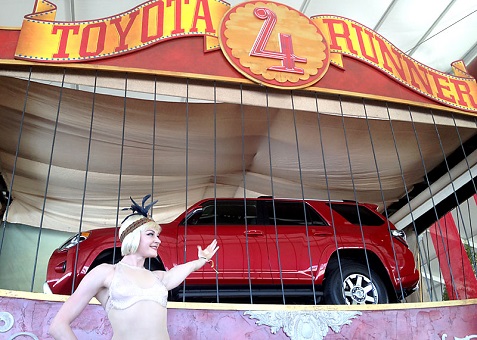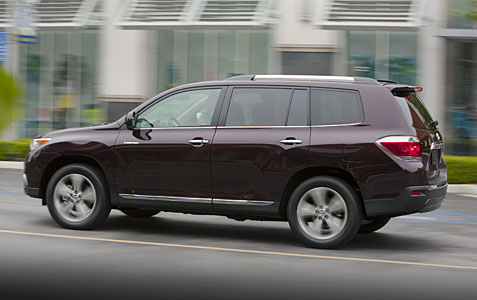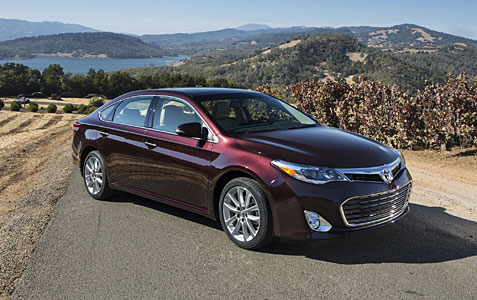First Drive: 2014 Toyota Tundra
The styling of the Toyota Tundra has been completely updated both inside and out for the 2014 model year which you’ll notice right away with the more muscular and chiseled front grille. Sales in the full-sized pickup truck market are booming this year and Toyota expects to grab its share of that market with the redesigned half-ton, full-size pickup truck. The 2014 Tundra will be available in 5 grades – SR, SR5, Limited, Platinum and a special 1794 Edition, which reflects a western lifestyle theme as a tribute to the ranch, founded in 1794, on which the Tundra plant is located in San Antonio. I traveled out to Knoxville, Tennessee for an up-close look at the new truck and a chance to drive it on a variety of roads.
Exterior
The redesign and the new front grille definitely enhance the look of the Tundra. It’s a great-looking truck as you can see from the photos above with the bold and powerful look that buyers expect in this segment. The Platinum version has a little less chrome and I liked that one the best, but buyers will have plenty of choices with the multiple trim levels. I liked the feature of having “TUNDRA” stamped into the sheet metal on the rear, and along with the new tail lamps the vehicle looks great from this angle. Toyota listened to customers who explained how they used the truck in rugged settings, so both the front and rear bumpers have been changed from one piece to three for lower replacement costs. Three cab styles are offered with the two-door Regular Cab, four-door Double Cab, and the super-sized four-door CrewMax. The Regular Cab and Double Cab models are offered in standard bed (78.7-inch) or long bed (97.6-inch) configurations and the CrewMax comes with a 66.7-inch bed, with all beds being 22.2-inches deep.
Interior
Many upgrades were made to the interior to make it more refined. The interior is very spacious and comfortable, and in the Limited, Platinum and 1794 editions buyers will find the luxury items you expect in higher end vehicles. I liked the leather seats and leather accents on the dash, particularly in the Platinum edition which featured perforated, diamond pleated premium leather seats, door and instrument panel inserts. The center stack screen and controls were laid out nicely and easy to use. The upgraded Entune audio system and app suite is easy to use with some nice customization features.
The rear seats in the CrewMax edition offer plenty of space for passengers and can now be folded up for additional cargo carrying capability as well.
Performance
The engine options remain the same on the new Tundra, as Toyota executives explained that drivers would not see any real-world mileage gains with a turbo V6 offered by competitors. Toyota’s most popular engine is the 5.7-liter, DOHC i-Force V8 which generates 381 horsepower at 5,600 rpm and 401 foot-pounds of peak torque at 3,600 rpm with a six-speed electronically controlled automatic transmission. Fuel efficiency on 4×2 models is 13 mpg city, 18 mpg highway and 16 mpg combined while the 4×4 achieves 13 mpg city/17 mpg highway/15 mpg combined. My test vehicles featured this engine and it performed nicely on roads that varied from winding hills at various speeds and inclines to highway driving. The Tundra was a pleasure to drive and it handled well.
Toyota also offers a 4.6-liter, DOHC i-Force V8 offers 310 horsepower at 5,600 rpm and 327 foot-pounds of peak torque at 3,400rpm that gets slightly better fuel mileage.
Buyers can also choose a 4.0-liter Dual Overhead Cam (DOHC) V6 which is standard on Tundra Regular and Double Cab models and produces 270 horsepower at 5,600 rpm and 278 foot-pounds of peak torque at 4,400 rpm. It is paired with a five-speed automatic transmission with uphill/downhill shift logic. EPA-estimated fuel economy is 16 mpg city, 20 mpg highway and 17 mpg combined.
Drivers can control the driving experience to adapt to road surfaces or driving conditions. In “normal” mode, Vehicle Stability Control (VSC), Traction Control (TRAC) and Automatic Limited-Slip Differential (Auto-LSD) all function to help enable traction and control capability. These modes can then be turned off to adjust to various conditions.
Overview
Toyota executives are stressing the “American-born” nature of the new Tundra which should play well with buyers in this segment. The redesigned Tundra was once again engineered by Toyota Technical Center in Ann Arbor and the design was created by Calty Design Research centers in Newport Beach and Ann Arbor. The Tundra is assembled in San Antonio and its V6 and V8 engines are built in Alabama while transmissions are built in North Carolina.
The large truck segment is very competitive with excellent products, but it’s also growing like crazy as the economy improves. The new Tundra will definitely catch the eye of buyers and we recommend test driving it if you’re looking for a big truck. Toyota has a well-deserved reputation for durability and reliability which is important if you’re looking for a workhorse.
You can follow us on Twitter and Facebook for content updates. Also, sign up for our email list for weekly updates and check us out on Google+ as well.
Posted in: Car Reviews, Cars
Tags: auto photos, auto slideshow, automobile photo gallery, autos, autos for guys, autos for men, car info for men, car photo gallery, car photos, car reviews, car slideshow, first drive, first drive automobile reviews, first drive car reviews, first drive reviews for guys, first drive reviews for men, new automobiles, new autos, new cars, pickup truck reviews, pickup trucks, Toyota, Toyota Tundra review


































